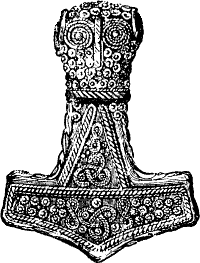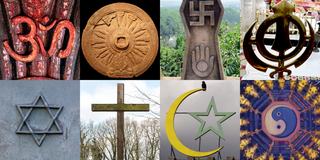
Heathenry is a modern Pagan new religious movement that has been active in the United States since at least the early 1970s. Although the term "Heathenry" is often employed to cover the entire religious movement, different Heathen groups within the United States often prefer the term "Ásatrú" or "Odinism" as self-designations.

Modern paganism, also known as contemporary paganism and neopaganism, is a type of religion or family of religions influenced by the various historical pre-Christian beliefs of pre-modern peoples in Europe and adjacent areas of North Africa and the Near East. Although they share similarities, contemporary pagan movements are diverse and as a result, they do not share a single set of beliefs, practices, or texts. Scholars of religion often characterise these traditions as new religious movements. Some academics who study the phenomenon treat it as a movement that is divided into different religions while others characterize it as a single religion of which different pagan faiths are denominations.

Wicca, also known as "The Craft", is a modern pagan, syncretic, earth-centered religion. Considered a new religious movement by scholars of religion, the path evolved from Western esotericism, developed in England during the first half of the 20th century, and was introduced to the public in 1954 by Gerald Gardner, a retired British civil servant. Wicca draws upon ancient pagan and 20th-century hermetic motifs for theological and ritual purposes. Doreen Valiente joined Gardner in the 1950s, further building Wicca's liturgical tradition of beliefs, principles, and practices, disseminated through published books as well as secret written and oral teachings passed along to initiates.

Drawing Down the Moon: Witches, Druids, Goddess-Worshippers, and Other Pagans in America Today is a sociological study of contemporary Paganism in the United States written by the American Wiccan and journalist Margot Adler. First published in 1979 by Viking Press, it was later republished in a revised and expanded edition by Beacon Press in 1986, with third and fourth revised editions being brought out by Penguin Books in 1996 and then 2006 respectively.

A religious symbol is an iconic representation intended to represent a specific religion, or a specific concept within a given religion.

The Covenant of the Goddess (CoG) is a cross-traditional Wiccan group of solitary Wiccan practitioners and over one hundred affiliated covens. It was founded in 1975 in order to increase co-operation among witches and to secure for witches and covens the legal protection enjoyed by members of other religions. Member covens generally focus theology and ritual around the worship of the Goddess and the Old Gods, which is general practice within Wicca. The Covenant of the Goddess operates largely by consensus and maintains strict autonomy for all members.

Celtic neopaganism refers to any type of modern paganism or contemporary pagan movements based on the ancient Celtic religion. One approach is Celtic Reconstructionism (CR), which emphasizes historical accuracy in reviving Celtic traditions. CR practitioners rely on historical sources and archaeology for their rituals and beliefs, including offerings to spirits and deities. Language study and preservation are essential, and daily life often incorporates ritual elements. While distinct from eclectic pagan and neopagan witchcraft traditions, there is some overlap with Neo-druidism.

Selena Fox is a Wiccan priestess, interfaith minister, environmentalist, pagan elder, author, and lecturer in the fields of pagan studies, ecopsychology, and comparative religion.

Patrick Dana Stewart was a soldier in the United States Army. He died in combat in Afghanistan when his Chinook helicopter was shot down by a rocket-propelled grenade while returning to base. Patrick Stewart was a resident of Fernley, Nevada, United States and a practicing Wiccan.

The United States Department of Veterans Affairs (VA) maintains many cemeteries specifically devoted to veterans. Most have various rules regarding what must take place in order to be interred there.

In the neopagan religion of Wicca a range of magical tools are used in ritual practice. Each of these tools has different uses and associations and are commonly used at an altar, inside a magic circle.
Circle Sanctuary is a non-profit organization and legally recognized neopagan church based in southwestern Wisconsin, US. It aims to encourage community celebrations, spiritual healing, research, networking and education.
Modern pagans are a religious minority in every country where they exist and have been subject to religious discrimination and/or religious persecution. The largest modern pagans communities are in North America and the United Kingdom, and the issue of discrimination receives most attention in those locations, but there are also reports from other countries.
Modern paganism in the United States is represented by widely different movements and organizations. The largest modern pagan religious movement is Wicca, followed by Neodruidism. Both of these religions or spiritual paths were introduced during the 1950s and 1960s from Great Britain. Germanic Neopaganism and Kemetism appeared in the US in the early 1970s. Hellenic Neopaganism appeared in the 1990s.

The Modern Pagan movement in the United Kingdom is primarily represented by Wicca and Neopagan witchcraft, Druidry, and Heathenry. 74,631 people in England, Scotland and Wales identified as either as Pagan or a member of a specific Modern Pagan group in the 2021 UK Census.
Minnesota's Twin Cities region is home to a large community of Wiccans, Witches, Druids, Heathens, and a number of Pagan organizations. Some neopagans refer to the area as "Paganistan". In the Handbook of Contemporary Paganism, Murphy Pizza characterizes the Minnesota Pagan community as "eclectic" and comprising "many different groups - Druid orders, Witch covens, legal Pagan churches, ethnic reconstructionist groups, and many more solitaries, interlopers and poly-affiliated Pagans".

Religious symbolism in the United States military includes the use of religious symbols for military chaplain insignia, uniforms, emblems, flags, and chapels; symbolic gestures, actions, and words used in military rituals and ceremonies; and religious symbols or designations used in areas such as headstones and markers in national cemeteries, and military ID tags.

A Community of Witches: Contemporary Neo-Paganism and Witchcraft in the United States is a sociological study of the Wiccan and wider Pagan community in the Northeastern United States. It was written by American sociologist Helen A. Berger of the West Chester University of Pennsylvania and first published in 1999 by the University of South Carolina Press. It was released as a part of a series of academic books entitled Studies in Comparative Religion, edited by Frederick M. Denny, a religious studies scholar at the University of Chicago.
Pierre Claveloux Davis, also known as Pete Pathfinder, was a religious figure in modern Paganism. He founded the Aquarian Tabernacle Church (ATC) in 1985, in Index, Washington, and served as its archpriest. He was also involved with several publications and related organizations. Davis advocated for Wicca and Paganism as an expert witness, and was part of a group of people who successfully petitioned for the pentacle to be available as a symbol used on U.S. veteran's headstones.















